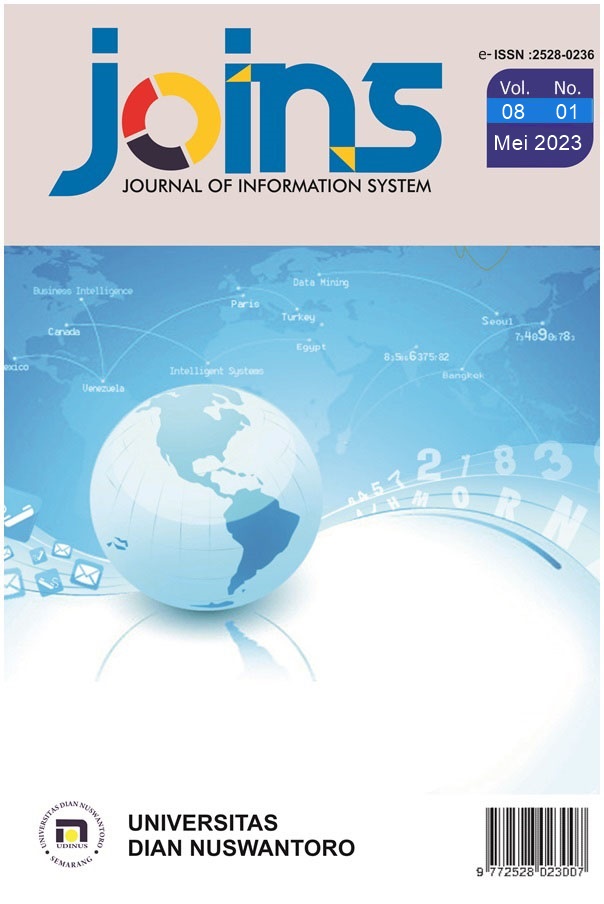Web-Based Payroll Application Design and Development Using Rapid Application Development
DOI:
https://doi.org/10.33633/joins.v8i1.7979Keywords:
information system, payroll, rad, wfh, hrdAbstract
Payroll is a system used by a company to manage the payment of the employees. The payroll system makes it simpler for HR to pay all employees' salaries each month. It is challenging for employees who work from home (WFH) to be present due to the COVID-19 epidemic. The HR department needs help overseeing and monitoring employee absences and regulating compensation. In response to these issues, a web-based information system was developed to simplify employee attendance tracking and to aid the Human Resource Division's (HRD) supervision and management of staff tasks and compensation. The system has undergone testing in the employee attendance phase, the validation process by the HRD Division and checking the results of the test and several factors starting from logging in to the payroll reporting process and the results of the UAT test on average meet the success rate indicators to be implemented into the company.References
NS Setiawan and AR Fitrianto, "The Influence of Work from Home (WFH) on Employee Performance During the COVID-19 Pandemic," Journal of Educational Sciences, vol. 5, no. 3, p. 3229-3242, 2021.
IK Alimuddin, "The Influence of Work from Home on Employee Performance During the Covid-19 Pandemic, Case Study at Bank BTN," Journal of Management, vol. 4, no. 2, p. 323-332, 2021.
M. Adieb, “Payroll: As It Is, Benefits, Payment Dates, Causes of Changes in Salary,” 10 02 2022. [Online]. Available: https://glints.com/id/lowongan/payroll-is/#.Ykl8a9tBy3A. [Accessed 03 04 2022].
Safrian Aswati, Ada Udi Firmansyah, M. Sabir Ramadhan, and Khairil Anwar, “Study Analysis of Rapid Application Development Models in Information System Development”, Journal Matrix, vol. XVI, no. 2, p. 20-27, 2017.
Sutiyono and Santi, "Membangun Sistem Informasi Pendaftaran Siswa Baru Berbasis Web dengan Metode MDD (Model Driven Development) di Raudhatul Athfal Nahjussalam," Jurnal Sistem Informasi, J-SIKA, vol. II, no. 1, pp. 50-60, 2020.
S. Aswati and Y. Siagian, "Model Rapid Application Development Dalam Rancang Bangun Sistem Informasi Pemasaran Rumah (Studi Kasus: Perum Perumnas Cabang Medan)," SESINDO, pp. 318-324, 2016.
Y. D. Wijaya and M. W. Astuti, "Pengujian Blackbox Sistem Informasi Penilaian Kinerja Karyawan PT Inka (Persero) Berbasis Equivalence Partitions," Jurnal Digital Teknologi Informasi, vol. IV, no. 1, pp. 22-26, 2021.
A. Dennis, B. H. Wixom and R. M. Roth, Systems Analysis and Design: An Object-Oriented Approach with UML, Wiley, 2017.
"Tentang Kami," 2021. [Online]. Available: https://polytron.co.id/tentang-kami/. [Accessed 18 4 2022].
S. Matende and P. Ogao, “Enterprise resource planning (ERP) system implementation: a case for user participation,” Procedia Technol., vol. 9, pp. 518–526, 2013.
K. Sindo, “8 Juta UMKM Ditarget Bertransaksi Online Pada 2019,” Kementrian Komunikasi dan Informatika RI, 2018. https://www.kominfo.go.id/content/detail/14587/8-juta-umkm-ditarget-bertransaksi-online-pada-2019/0/sorotan_media (accessed Apr. 06, 2023).
Kendall, K. E., dan Kendall, J. E. 2010. Analisis dan Perancangan Sistem. Jakarta: PT Indeks
Trimahardhika, R. dan E. S. (2017). Pengguna Metode Rapid Application Development Daam Perancangan Sistem Informasi Perpustakaan. Jurnal Informatika, 4 No. 2(2), 249–260. http://ejournal.bsi.ac.id/ejurnal/index.php/ji/article/view/2226
Kaban, R., Danur, S. R., & Zuliaty, R. (2022). Penerapan Metode Rapid Application Development (RAD) dalam Perancangan Sistem Informasi Penjualan Berbasis Web. Jurnal Informatika Dan Perancangan Sistem (JIPS), 4(2), 1–7. https://jurnal.itbi.ac.id/index.php/journalinformatika/ article/view/36/8
Downloads
Published
How to Cite
Issue
Section
License
Authors who publish with this journal agree to the following terms:
- Authors retain copyright and grant the journal right of first publication with the work simultaneously licensed under a Creative Commons Attribution License that allows others to share the work with an acknowledgement of the work's authorship and initial publication in this journal.
- Authors are able to enter into separate, additional contractual arrangements for the non-exclusive distribution of the journal's published version of the work (e.g., post it to an institutional repository or publish it in a book), with an acknowledgement of its initial publication in this journal.
- Authors are permitted and encouraged to post their work online (e.g., in institutional repositories or on their website) prior to and during the submission process, as it can lead to productive exchanges, as well as earlier and greater citation of published work (See The Effect of Open Access).

This work is licensed under a Creative Commons Attribution 4.0 International License.






















